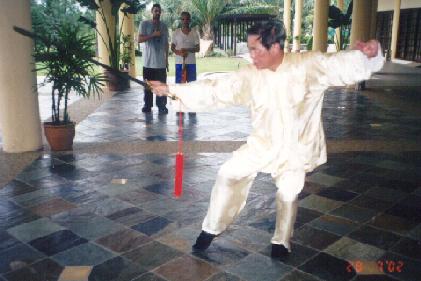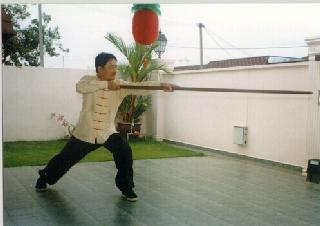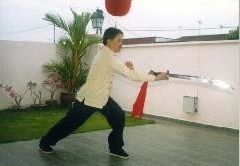SELECTION OF QUESTIONS AND ANSWERS
OCTOBER 2014 PART 3

Grandmaster Wong and Sifu Roland touring beautiful Switzerland where the real scenery is like a painted picture
Question 1
I have been practicing martial arts for 13 years now and currently practice independently. While I have confidence in my verity of skills, no one has ever taught me how to fight multiple attackers. As your name came up in conversations with fellow martial artists I wanted to seek advice from you. I've heard of your many accolades and I'm sure a skilled master such as yourself could help me.
— Sensei Lewis, USA
Answer
There are two main strategies when fighting against multiple opponents, namely "Fighting with a Fort Behind" and "Entering a Herd of Sheep".
In "Fighting with a Fort Behind", an exponent has his back to a wall while fighting multiple opponetns. The rationale is that no one would attack him from behind.
There is, however, a serious weakness. If two or more opponents attack him at the same time, he would have difficulty, facing a situation expressed as "two fists cannot match four hands".
In "Entering a Herd of Sheep", an exponent moves about constantly amongst multiple opponents. The rationale is that as he is constantly moving about, he escapes being hit even when many opponents attack him at the same time.
In the past "Fighting with a Fort Behind" was more often used by exponents in South China, whereas "Entering a Herd of Shoop" in the the north. This was because of geographical considerations. The narrow lanes in South China enabled an exponent to fight one opponent at a time even when there might be many more opponents behind the first one. The open plain in North China favoured "Entering a Herd of Sheep"
Personally I preferred "Entering a Herd of Sheep". In my young days when fighting was not uncommon, I used this strategy successfully to escape ambushes.
Some combat principles are employed in both "Fighting with a Fort Behind" and "Entering a Herd of Sheep", such as "using a shield" and "entangling opponents". But the most important principle is "finding an escape route". This is in line with the kungfu principle of "emerging in any combat unhurt", which is in contrast to "winning at all cost" found in some martial arts.
There are two strategies when finding an escape route. One is "capture the leader", when an exponent is in a strong position, and the other is "kill a chicken to frighten the monkeys" when the exponent is in a weak position.
"Capture the leader" is to strike down the leader or the most formidable of the multiple opponents. When he is down, the others will stop fighting or run away. "Kill a chicken to frighten the monkeys" is to strike the weakest of the opponents. When he is down or avoid the exponent's attack, the exponent has an opening to run away.
Some videos showing how to fight against multiple opponents are shown here and here.
Question 2
For those of us that are near-sighted and wear glasses and contacts, can we take the skill from Bone Marrow Cleansing to direct chi to massage our eyes?
— Steven, USA
Answer
Yes, you can.
An even better approach is to practice the Shaolin Eight Eye Exercises. Please make a search in my Question-Answer Series using Google Search, and you can find a lot of information about the Eight Eye Exercises.
You should perform the exercises without wearing glasses or contact lens, and also don't wear them as much as possible during all other times.

Grandmaster Wong performing the Wudang Sword
Question 3
I saw one of the Wahnam instructors in Switzerland performing the Wudang Sword on our website -- very inspiring. I hope to learn the Wudang Sword someday.
— John, Korea
Answer
He is Leo (Sifu Leonard) from Austria, but he is at present attending some chi kung and Taijiquan courses at Bern in Switzerland. The Wudang Sword is a beautiful set, and Leo performs it beautifully.
I am now enjoying myself traveling in Switzerland with Roland (Sifu Roland Mastel), Olga and Andrea (Sifu Andrea Zilio) after the courses in Bern, and before courses in Zurich tomorrow. When we were having a snack overlooking the River Rhine, I recalled my time with you having dinner by the River Han. I told them of the famous Korean general who built special boats with spike on them to repulse an overwhelming Chinese naval attack, demonstrating that strategy, not sheer number, was a key factor to secure victory.
Question 4
Should I do rotating-knees at the very end of my kung fu practice or should I do it directly after stance training in the middle of practice before I perform the Art of Flexibility?
Answer
You can perform Rotating Knees any time, i.e. before, after or separately from your kungfu practice, including the Art of Flexibility. Not only the physical rotating movement but also the chi flow is very important.

Sifu Goh Kok Hin demonstrating the Flowing Water Staff
Question 5
Is it OK to do calisthenics like push-ups as part of my Kung Fu training, for example before my final chi flow and standing meditation or should I do that separately?
Answer
Similarly you can perform calisthenics separately or as part of your kungfu training. If you perform it as part of your kungfu training, you can have it before or after any other aspects of your training.
Don't perform your calisthenics as physical exercise, though you can if you wish, but as chi kung. Initially you may have some questions or difficulty as how to do this, but as you progress you will find it easy. You will learn this when you attend my Intensive Chi Kung Course or Intensive Shaolin Kungfu Course. If I don't explain this during the course, please remind me.
When you have become proficient in chi kung, you can employ it in anything you do, including eating and making love. For example, instead of being tensed and thinking of various thoughts, and using your muscles when you eat, often without savouring its favour, you are relaxed and mentally clear, use your chi to do your eating and enjoy whatever you eat. Instead of tensing your muscles to do your push-up, and become physically tired and and mentally stressed after the work-out, you use your chi flow to do the push-up, and become physically realxed and mentally fresh afterward.
Many people may not know what I am saying here though they understand the dictionary meaning of every word. They are those who think they can learn kungfu or chi kung from books, or think every kungfu or chi kung teacher is the same.
On the other hand, this was what Sifu Yan Xin of China, one of the greatest chi kung masters the world has ever produced, meant when he said that a chu kung practitioner practiced chi kung 24 hours a day.
Question 6
During Golden Bridge my mind is focused on my Dan Tian when I am in "Dan Tian" mode. Many times I notice that my breath becomes connected with my Dan Tian and it becomes very natural for me to gently breath into my Dan Tian. This feels very relaxing and focusing and I notice that I can stay much longer in the stance. Is it safe for me to allow this to happen?
— Sifu Claudien, Malta
Answer
Yours is an advanced development of Golden Bridge. You pulsate with the Cosmos. I am glad of your development. Not many people, even masters, could attain this level.
At an even higher level, you forget about the breathing altogether. You don't breath in the modernl sense of the word, i.e. exchange of air with the environment through your nose and mouth, you breath in the classical sense, i.e. exchange of energy wth the Cosmos through your whole body. At the highest level you merge with the Cosmos.
This knowledge is for your intellectual understanding. You don't have to work at it in this way. Just practice Golden Bridge without worry, without intellectualization, and enjoying the practice. Let the progress come naturally.

CSifu Goh Kok Hin demonstrating the Plum Flower Sabre
Question 7
Is the traditional staff used for the "Flowing Water Staff" set 6 feet long or longer? Should it be a straight or tapered staff?
Answer
The staff is about 6 feet long. It can be slightly shorter or longer. It should be slightly tapering, and made of hard wood.
Question 8
Is the sabre best used for the "Plum Flower Single Sabre" set also called a broadsword or "dao" Is this sabre blade traditionally very rigid and strong or flexible? Or is the blade partly rigid and only the tip is flexible?
Answer
Yes, the sabre is also called a broadsword or "dao" in Chinese.
"Dao" is pronounce as /t'ao/ and not as /dao/ as it is often mispronounced. The Romanized Chinese "d" is pronounced like /t'/ in English, just as the Spanish "J" is pronounced like the English /H/, so "Jose" in Spanish is pronounced like /Hose/ and not as /Jose/.
"Dao" meaning a sabre is pronounced similarly as "Dao" meaning the Way, but in different tones which most Westerners may not be able to differentiate.
The blade of the sabre right to its tip should be rigid, not flexible. Flexible or flimsy sabres are for wushu demonstration.
LINKS
Selected Reading
- Wahnam Taijiquan against Muay Thai
- Intensive Zen Course, Umbrella and Space Sheep
- Is White Crane Steps on Snow Related to the Art of Lightness?
- Pressing with Chosen Sequence
- Counters against Felling Attack
